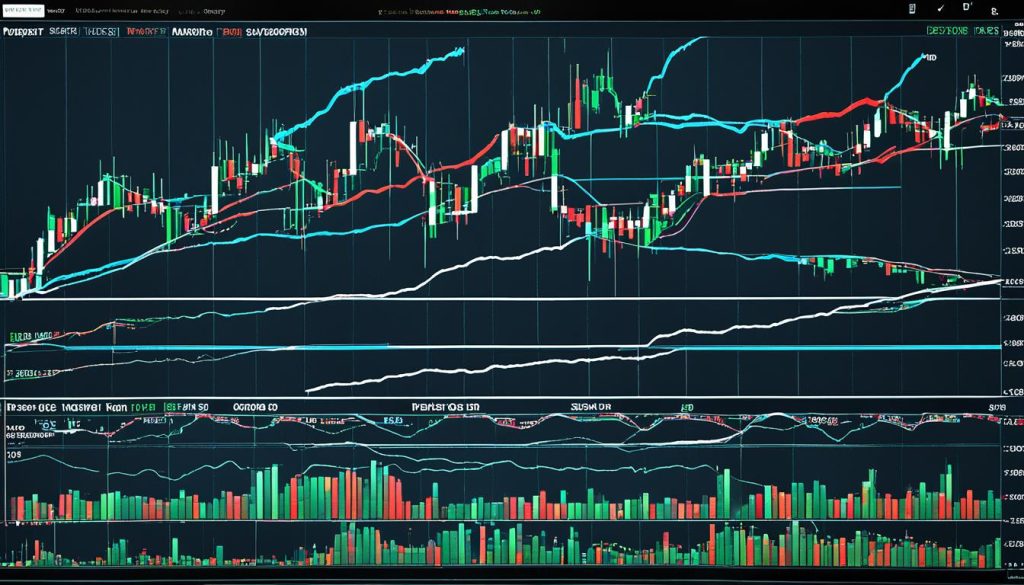Forex trading with multiple time frames gives traders a full view of market movements. By looking at short-term charts and long-term graphs, traders can understand trends better. This helps them make more accurate predictions and make better trading decisions.
Looking at currency pairs over different time scales shows both short-term and long-term trends. Using this strategy in your trading plan can improve risk management. It helps spot reliable signals and avoid false alarms.
Key Takeaways
- Multi-time frame analysis offers a comprehensive view of the market.
- Understanding various time frames improves decision-making.
- It aids in optimizing entry and exit points in trades.
- A holistic view helps in identifying reliable market signals.
- Improves risk management by filtering out noise and false signals.
Understanding Multi-Time Frame Analysis
In Forex trading, using multi-time frame analysis is a key strategy. It gives traders a full view of market trends over various time periods. This method helps traders understand market trends better and make better decisions.
Benefits of Multi-Time Frame Analysis
The benefits of multi-time frame analysis are many. They help traders manage risks better. Key advantages include:
- Improved Trend Identification: Seeing trends in short, medium, and long-term frames helps spot market direction clearly.
- Better Synchronization: Matching market entries and exits across time frames helps with strategic planning.
- Trade Confirmation: Using multiple time frames to confirm trades reduces the chance of false signals.
- Enhanced Risk Mitigation: Different time frames help in making informed risk management decisions, leading to a complete trading strategy.
Basic Concept of Multiple Time Frames in Forex
Multi-time frame analysis means looking at an asset through various time frames for a full view of market dynamics. Traders look at short-term, medium-term, and long-term charts for different insights.
Common Time Frames Used in Forex Trading
In Forex trading, several time frames are often used, each for different strategies and goals. Common ones include:
- Short-Term: 1-minute, 5-minute, and 15-minute charts give quick insights for day traders.
- Medium-Term: 1-hour and 4-hour charts are great for swing trading and catching mid-range trends.
- Long-Term: Daily, weekly, and monthly charts support long-term strategies and investment reviews.
Trading across different time frames lets traders mix quick market moves with broader trend analysis. This leads to stronger trading decisions.
Implementing Time Frame Analysis in Forex Trading
Learning about time frame analysis in Forex trading helps traders understand market trends better. By using multiple time frames in trading, traders can see both short-term moves and long-term trends. This guide will show you how to use time frame analysis effectively.
Step-by-Step Guide to Multi-Time Frame Analysis
To start with time frame analysis in Forex trading, follow these steps:
- Select Appropriate Time Frames: Pick short-term, medium-term, and long-term time frames. Day traders might use 15-minute, 1-hour, and 4-hour charts. Long-term traders might use daily, weekly, and monthly charts.
- Analyze Market Conditions: Look at the big picture with a higher time frame to see the trend. Then, check lower time frames for where to buy or sell. This way, you trade with the trend.
- Confirm Signals: Use different time frames and indicators to check trading signals. If a daily chart shows a bullish crossover, check shorter charts to confirm before trading.
Tools and Indicators for Time Frame Analysis
For time frame analysis in Forex trading, you need good tools and indicators. Here are some key ones:
- Moving Averages: These help spot trends and when they might change.
- Fibonacci Retracement Levels: These levels show where the market might stop or turn around.
- MACD (Moving Average Convergence Divergence): This tool is great for seeing the market’s speed and if it’s too fast or too slow.
Using these tools with multiple time frames in trading can really improve your analysis and trading results.
Forex Trading with Multiple Time Frames
Using multiple time frames in Forex trading gives traders a full view of the market. It helps spot trade setups, check market conditions, and find the best times to buy or sell. By mixing short-term and long-term time frames, traders can match their strategies with the best trading times.
First, look at a big picture with a daily or weekly chart to see the main market trend. Next, use a 4-hour or 1-hour chart to study the market more closely and find trade areas. Finally, a 15-minute or 5-minute chart is used to make precise entry and exit decisions.
Choosing a time frame also affects a trader’s mindset. Longer frames need patience and reduce stress from market noise. Shorter frames require fast decisions and handling lots of data.
Trading with multiple time frames improves technical skills and emotional control. These are key for steady trading success.
Let’s look at some common time frame combinations:
| Higher Time Frame | Medium Time Frame | Lower Time Frame |
|---|---|---|
| Daily | 4-Hour | 15-Minute |
| Weekly | Daily | 1-Hour |
| Monthly | Weekly | 4-Hour |
Popular Strategies Using Multiple Time Frames
Using multiple time frames in forex trading can make strategies more effective. Trend-following is a top method. It means spotting the main trend on a daily chart and then adjusting entry and exit points on a 4-hour or 1-hour chart. This way, traders follow the market’s direction and make trades with more precision.
Breakout trading is another strategy that uses multiple time frames. Traders look for key support and resistance on a higher time frame. Then, they use a lower time frame to find the best breakout spots. This method checks breakout points across different times, making trades more likely to succeed.
Position trading works well over longer periods and also uses multiple time frames. Traders use weekly charts to see major support and resistance. Then, they switch to daily charts for precise entry and exit points. This approach gives a wide view of the market while keeping trading tactics sharp.
Here’s a table comparing these strategies:
| Strategy | Primary Time Frame | Secondary Time Frame | Key Advantage |
|---|---|---|---|
| Trend-Following | Daily | 4-Hour/1-Hour | Aligns with prevailing market direction |
| Breakout Trading | Daily | 1-Hour/15-Minute | Validates breakout points across periods |
| Position Trading | Weekly | Daily | Broader market perspective |
By using these strategies with multiple time frames, traders can adjust to different market conditions. They can make better trading choices and improve their performance. Both advanced and new traders can learn a lot from analyzing multiple time frames, leading to smarter trading decisions.
Conclusion
Exploring forex trading with multiple time frames shows its complexity and potential to improve trading results. It starts with understanding multi-time frame analysis. This gives insights into how different time frames offer a full view of the market.
Using various tools and indicators is key to this strategy. These tools provide important data for making smart decisions.
Popular strategies using multiple time frames show how this approach can improve trading skills. It helps both new and experienced traders spot patterns and trends. This leads to better timing for entering and leaving the market.
In conclusion, forex trading with multiple time frames is essential for a strong trading plan. It helps traders understand the market better and trade more effectively. Experienced traders say learning in forex is ongoing.
It’s important to keep updating your strategies with the market. By learning and practicing, traders can develop strong trading habits. This leads to success in the unpredictable forex market.
FAQ
What is Forex trading with multiple time frames?
Forex trading with multiple time frames means looking at currency pairs over different time scales. This includes everything from minutes to months. It gives traders a full view of market trends. This helps them make better decisions by showing both short-term and long-term trends.
What are the benefits of multi-time frame analysis in Forex trading?
Using multiple time frames in Forex trading has many benefits. It helps identify trends better and ensures market entries and exits are in sync. It also confirms trades and reduces risks. By looking at different time scales, traders get a clear view of the market. This leads to more accurate trading decisions.
What are common time frames used in Forex trading?
Forex traders use time frames from very short (1-minute, 5-minute charts) to long (daily, weekly charts). The choice depends on the trader’s style and goals. Whether it’s scalping, day trading, or swing trading, each time frame has its own purpose.
How can I implement time frame analysis in Forex trading?
To use time frame analysis in Forex trading, pick the right time frames for your trading style. Look at the market across these frames and use tools like moving averages and Fibonacci levels. This helps spot good trade opportunities and when to enter or exit the market.
What are some popular strategies using multiple time frames?
Strategies like trend-following, breakout trading, and position trading benefit from using multiple time frames. This approach improves trade confirmations and helps understand market conditions better. It’s great for adapting to market changes and boosting trading success.
How does the choice of time frame affect my Forex trading performance?
The time frame you choose can greatly impact your trading performance. Shorter frames need quick decisions and can be stressful. Longer frames offer a broader view and allow for more thoughtful decisions. Picking the right time frame for your strategy and comfort level is key to success.






